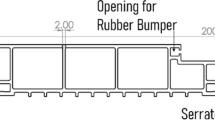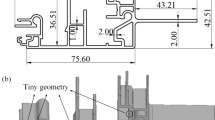The possibility is demonstrated of refined design by numerical modeling for molding channel geometry in extrusion heads for manufacturing plastic profiles. The aim of modeling is determination of channel head shape providing balanced flow at the die exit. The feasibility of modifying the molding channel using an optimization algorithm makes it possible to calculate molding channel head geometry for prescribed extruded object dimensions. A fluid dynamics Ansys Polyflow software package is used for extrusion head development.




Similar content being viewed by others
References
V. S. Kim, Polymer Extrusion Practice and Theory [in Russian], Khimiya, KolosS, Moscow (2005).
H. A. Metwally, Methodology for Superior Die Design – Combining the Best of Art and Science, Fluent INC.
M. M. Kostic and L. G. Reifschneider, “Design of extrusion dies,” in: Encyclopedia of Chemical Processing (2006), pp. 633–649.
V. Sivetskii, D. E. Sidorov, and O. L. Sokol’skii, Computer Simulation and Design of Extruded Polymer Equipment [in Ukrainian], NTUU KPI, Kiev (2007).
O. S. Carneiro and J. M. Nobrega, “Recent developments in automatic die design for profile extrusion,” Plastics Rubber and Composites, 33, 400–408 (2004).
O. S. Sakharov, V. I. Sivetskii, and O. L. Sokol’skii, “Computer simulation of the process of flow of melts of polymers in molding channels,” in: Proc. Seminar Container and Packaging Industry, Mir Upakovki, Kiev (2002).
M. Biba and S. Stebunov, “Simulation system for optimization of profile extrusion,” Quantor Form. (2004).
M. M. Kostic and L. G. Reifschneider, “Computational design of a U-profile die and calibrator,” ANTEC, 246–250 (2004).
J. Sienz, A. Goublomme, and M. Luegem, “Sensitivity analysis for the design of profile extrusion dies,” Computers and Structures, 88, 610–624 (2010).
A. L. Graham and T. Tran-Cong, “An inverse problem by boundary element method,” Polymer Eng. Sci. (1996).
ANSYS POLYFLOW, User’s Guide, Ansys Inc. (2010).
A. A. Lomov, M. Yu. Zalunaev, and G. M. Koncharov, “Optimization of extrusion head profiling channel shape in order to obtain ribbon billets from a rubber mix,” Khim. Neftegaz. Mashinostr., No. 2, 9–11 (2001).
V. I. Sivetskii, O. S. Sakharov, O. L. Sokol’skii, and D. D. Ryabinin, Near-Wall Effects in Processes of Polymer Material Treatment [in Ukrainian], NTUU KPI, Kiev (2009).
Author information
Authors and Affiliations
Corresponding author
Additional information
Translated from Khimicheskoe i Neftegazovoe Mashinostroenie, No. 10, pp. 25–27, October, 2013.
Rights and permissions
About this article
Cite this article
Kovalenko, K.G., Sivetskii, V.I. & Sokol’skii, A.L. Design of an Extrusion Die for Plastic Profiles. Chem Petrol Eng 49, 675–678 (2014). https://doi.org/10.1007/s10556-014-9817-x
Published:
Issue Date:
DOI: https://doi.org/10.1007/s10556-014-9817-x




